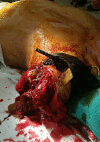Rethinking limb tourniquet conversion in the prehospital environment
- PMID: 37678162
- PMCID: PMC10662576
- DOI: 10.1097/TA.0000000000004134
Rethinking limb tourniquet conversion in the prehospital environment
Abstract
We have highlighted the issue of overuse of tourniquets and described why tourniquet conversion and replacement should be taught and done in the prehospital setting.
Figures







References
-
- Wolff LH, Adkins TF. Tourniquet problems in war injuries. Bulletin of the US Army Medical Department. 1945;77–85.
-
- Cosmas Graham A. and Albert E Cowdrey (Eds). (1992). Page 363. The Medical Department - Medical Service in the European Theater of Operations—U.S. Army Center of Military History. Accessed 8 Aug 2023
-
- Mabry RL. Tourniquet use on the battlefield. Mil Med. 2006;171(5):352–356. - PubMed
-
- Mabry RL, Holcomb JB, Baker AM, Cloonan CC, Uhorchak JM, Perkins DE, Canfield AJ, Hagmann JH. United States Army Rangers in Somalia: an analysis of combat casualties on an urban battlefield. J Trauma. 2000;49(3):515–528; discussion 528–529. - PubMed
-
- Butler FK, Jr., Hagmann J, Butler EG. Tactical combat casualty care in special operations. Mil Med. 1996;161(Suppl):3–16. - PubMed
MeSH terms
LinkOut - more resources
Full Text Sources
Medical

